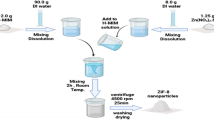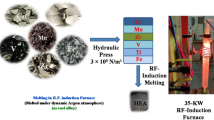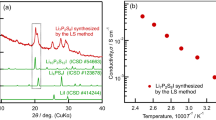Abstract
In the present work, preceramic nanocrystallite barium cerate (BaCeO3) was successfully synthesized using the hydrazine-nitrate combustion method. Using carbon-free hydrazine (N2H4) as fuel significantly reduced the formation of carbonate by-products. Subsequent annealing of combustion products in the air atmosphere at temperatures in the range of 500–1000 °С yielded preceramic powders based on chemically and phase-pure BaCeO3. Characterization of the as-received powders was performed by X-ray diffraction, energy-dispersive X-ray spectroscopy (EDXS), scanning electron microscopy (SEM), simultaneous thermal analysis (DTA-TGA) and adsorption-structural analysis (N2, 77 K). Thermophysical properties of the sample annealed at 1000 °С were investigated using laser flash analysis (LFA) in the temperature interval of 1000 °С. As a result of a comprehensive study, the sequence of chemical and phase transformations that lead to the formation of barium cerate with a rhombic structure (Pnma, a = 6.2145 Å, b = 8.7776 Å, c = 6.2337 Å) during the thermal processing of combustion products was investigated. It was established that the average size of the obtained nanocrystals is 38 ± 3 nm and that they form micron-sized agglomerates with a specific surface area of the powder of 4.8 m2/g. It was shown that the sintered sample of barium cerate is characterized by thermal diffusivity values of 0.28 to 0.20 mm2/s and thermal conductivity values of 0.41–0.35 W/mK, depending on temperature. These results, given the impact of porosity on the sample (~40%), show very good agreement with the thermophysical characteristics of densely sintered ceramics based on BaCeO3—a solid oxide electrolyte SOFC. Consequently, the proposed method of hydrazine-nitrate synthesis of barium cerate presents itself as a promising approach to obtaining preceramic powders and ceramics in the area of solid oxide fuel cells.

Graphical Abstract
Highlights
-
Novel hydrazine-nitrate combustion route was proposed to synthesize BaCeO3 nanopowder.
-
Thermal treatment of combustion products leads to chemically and phase pure BaCeO3.
-
Crystallite size and its aggregation outperform those for conventional approaches.
-
Thermophysical performance of BaCeO3 powders makes it promising for SOFC ceramics.









Similar content being viewed by others
References
Shri Prakash B, Pavitra R, Senthil Kumar S, Aruna ST (2018) Electrolyte bi-layering strategy to improve the performance of an intermediate temperature solid oxide fuel cell: a review. J Power Sources 381:136–155. https://doi.org/10.1016/j.jpowsour.2018.02.003
da Silva FS, de Souza TM (2017) Novel materials for solid oxide fuel cell technologies: a literature review. Int J Hydrogen Energy 42:26020–26036. https://doi.org/10.1016/j.ijhydene.2017.08.105
Panthi D, Hedayat N, Du Y (2018) Densification behavior of yttria-stabilized zirconia powders for solid oxide fuel cell electrolytes. J Adv Ceram 7:325–335. https://doi.org/10.1007/s40145-018-0282-4
Liu C, Zhang H, Xia J, Li Z (2012) Synthesis and characterization of Zr0.85Y0.15O1.925-La9.33Si6O26 composite electrolyte for application in SOFCs. J Adv Ceram 1:327–335. https://doi.org/10.1007/s40145-012-0033-x
Saad MMusa (2017) Investigation on structural, electronic and magnetic properties of perovskites SrMO3 (M = Mn and Co) via GGA and GGA + U methods. J Sci Adv Mater Devices. 2:115–122. https://doi.org/10.1016/j.jsamd.2017.02.001
Jun A, Kim J, Shin J, Kim G (2016) Perovskite as a cathode material: a review of its role in solid-oxide fuel cell technology. ChemElectroChem 3:511–530. https://doi.org/10.1002/celc.201500382
Shu L, Sunarso J, Hashim SS, Mao J, Zhou W, Liang F (2019) Advanced perovskite anodes for solid oxide fuel cells: a review. Int J Hydrogen Energy. 44:31275–31304. https://doi.org/10.1016/j.ijhydene.2019.09.220
Afroze S, Karim AH, Cheok Q, Eriksson S, Azad AK (2019) Latest development of double perovskite electrode materials for solid oxide fuel cells: a review. Front Energy. 13:770–797. https://doi.org/10.1007/s11708-019-0651-x
Sunarso J, Hashim SS, Zhu N, Zhou W (2017) Perovskite oxides applications in high-temperature oxygen separation, solid oxide fuel cell and membrane reactor: a review. Prog Energy Combust Sci 61:57–77. https://doi.org/10.1016/j.pecs.2017.03.003
Medvedev D, Murashkina A, Pikalova E, Demin A, Podias A, Tsiakaras P (2014) BaCeO3: materials development, properties and application. Prog Mater Sci 60:72–129. https://doi.org/10.1016/j.pmatsci.2013.08.001
Xie K, Yan R, Chen X, Dong D, Wang S, Liu X, Meng G (2009) A new stable BaCeO3-based proton conductor for intermediate-temperature solid oxide fuel cells. J Alloys Compd 472:551–555. https://doi.org/10.1016/j.jallcom.2008.05.036
Lyagaeva J, Danilov N, Vdovin G, Bu J, Medvedev D, Demin A, Tsiakaras P (2016) A new Dy-doped BaCeO3-BaZrO3 proton-conducting material as a promising electrolyte for reversible solid oxide fuel cells. J Mater Chem A 4:15390–15399. https://doi.org/10.1039/c6ta06414k
Medvedev DA, Murashkina AA, Demin AK (2015) Formation of dense electrolytes based on BaCeO3 and BaZrO3 for application in solid oxide fuel cells: the role of solid-state reactive sintering. Rev J Chem 5:193–214. https://doi.org/10.1134/s2079978015030024
Zolkos M (2005) The democratic impact of international organizations. Int Stud Rev 7:478–480. https://doi.org/10.1111/j.1551-2916.2005.00521.x
Verbov R, Kavecansk V, Diko P, Antal V (2018) Synthesis of nanocrystalline BaCeO3 by oxalate coprecipitation for YBa2Cu3O7 bulk superconductors. Acta Phys Pol A 133:82–85. https://doi.org/10.12693/APhysPolA.133.82
Lee DW, Won JH, Shim KB (2003) Low-temperature synthesis of BaCeO3 nanopowders by the citrate process. Mater Lett 57:3346–3351. https://doi.org/10.1016/S0167-577X(03)00072-7
Glavee GN, Hunt RD, Paranthaman M (1999) Low-temperature preparation of BaCeO3 and Ce0.75Zr0.25O2 thin films using sol-gel processing techniques. Mater Res Bull 34:817–825. https://doi.org/10.1016/S0025-5408(99)00061-6
Ouzaouit K, Benlhachemi A, Benyaich H, Dallas JP, Villain S, Musso JA, Gavarri JR (2006) Electrical conductivity of BaCeO3 synthesized by new sol-gel method Lattice Pnma Pnma. Powder Diffr 7:94–97
Orlov AV, Shlyakhtin OA, Vinokurov AL, Knotko AV, Tretyakov YD (2005) Preparation and properties of fine BaCeO3 powders for low-temperature sintering. Inorg Mater 41:1194–1200. https://doi.org/10.1007/s10789-005-0286-7
Medvedev D, Maragou V, Pikalova E, Demin A, Tsiakaras P (2013) Novel composite solid-state electrolytes on the base of BaCeO3 and CeO2 for intermediate temperature electrochemical devices. J Power Sources 221:217–227. https://doi.org/10.1016/j.jpowsour.2012.07.120
Bezerra Lopes FW, Arab M, Macedo HP, de Souza CP, de Souza JF, Gavarri JR (2012) High-temperature conduction and methane conversion capability of BaCeO3 perovskite. Powder Technol 219:186–192. https://doi.org/10.1016/j.powtec.2011.12.039
Wang J, Huang C, Chen X, Zhang H, Li Z, Zou Z (2015) Photocatalytic CO2 reduction of BaCeO3 with 4f configuration electrons. Appl Surf Sci 358:463–467. https://doi.org/10.1016/j.apsusc.2015.08.063
E Kalinina, E Pikalova, A Kolchugin, N Pikalova, A Farlenkov, Comparative study of electrophoretic deposition of doped BaCeO3-based films on La2NiO4+δ and La1.7Ba0.3NiO4+δ cathode substrates, Materials 12 (2019). https://doi.org/10.3390/ma12162545.
Popkov VI, Almjasheva OV, Panchuk VV, Semenov VG, Gusarov VV (2016) The role of pre-nucleus states in formation of nanocrystalline yttrium orthoferrite. Dokl Chem 471:356–359. https://doi.org/10.1134/S0012500816120041
Popkov VI, Almjasheva OV, Gusarov VV (2014) The investigation of the structure control possibility of nanocrystalline yttrium orthoferrite in its synthesis from amorphous powders. Russ J Appl Chem 87:1417–1421. https://doi.org/10.1134/S1070427214100048
Popkov VI, Almjasheva OV, Schmidt MP, Izotova SG, Gusarov VV (2015) Features of nanosized YFeO3 formation under heat treatment of glycine-nitrate combustion products. Russ J Inorg Chem 60:1193–1198. https://doi.org/10.1134/S0036023615100162
Liu G, Li J, Chen K (2013) Combustion synthesis of refractory and hard materials: a review. Int J Refract. Met Hard Mater 39:90–102. https://doi.org/10.1016/j.ijrmhm.2012.09.002
Varma A, Mukasyan AS, Rogachev AS, Manukyan KV (2016) Solution combustion synthesis of nanoscale materials. Chem Rev 116:14493–14586. https://doi.org/10.1021/acs.chemrev.6b00279
Patil KC, Aruna ST, Mimani T (2002) Combustion synthesis: an update. Curr. Opin. Solid State Mater. Sci. 6:507–512. https://doi.org/10.1016/S1359-0286(02)00123-7
Martinson KD, Kondrashkova IS, Popkov VI (2017) Synthesis of EuFeO3 nanocrystals by glycine-nitrate combustion method. Russ J Appl Chem 90:1214–1218. https://doi.org/10.1134/S1070427217080031
Kondrashkova IS, Martinson KD, Zakharova NV, Popkov VI (2018) Synthesis of nanocrystalline hofeo3 photocatalyst via heat treatment of products of glycine-nitrate combustion. Russ J Gen Chem 88:2465–2471. https://doi.org/10.1134/S1070363218120022
Popkov VI, Tolstoy VP, Semenov VG (2020) Synthesis of phase-pure superparamagnetic nanoparticles of ZnFe2O4 via thermal decomposition of zinc-iron layered double hydroxysulphate. J Alloys Compd 813:152179. https://doi.org/10.1016/j.jallcom.2019.152179
Popkov VI, Almjasheva OV, Nevedomskiy VN, Panchuk VV, Semenov VG, Gusarov VV (2018) Effect of spatial constraints on the phase evolution of YFeO3-based nanopowders under heat treatment of glycine-nitrate combustion products. Ceram Int 44:20906–20912. https://doi.org/10.1016/j.ceramint.2018.08.097
Zvereva VV, Popkov VI (2019) Synthesis of CeO2 – Fe2O3 nanocomposites via controllable oxidation of CeFeO3 nanocrystals. Ceram Int 45:12516–12520. https://doi.org/10.1016/j.ceramint.2019.03.188
Scholten MJ, Schoonman J, van Miltenburg JC, Cordfunke EHP (1995) The thermodynamic properties of BaCeO3 at temperatures from 5 to 940 K. Thermochim Acta 268:161–8. https://doi.org/10.1016/0040-6031(95)02431-X
Yamanaka S, Hamaguchi T, Oyama T, Matsuda T, Ichi Kobayashi S, Kurosaki K (2003) Heat capacities and thermal conductivities of perovskite-type BaZrO3 and BaCeO3. J Alloys Compd 359:1–4. https://doi.org/10.1016/S0925-8388(03)00137-3
Granovskii V, Stepanova D, Lysyak A (1970), Preparation of barium hexaferrite from mixtures of ferric oxide and barium nitrate or barium oxides and from mixtures produced by nonceramic methods. Powder Metall Met Ceram 9:895–901. https://doi.org/10.1007/BF00803788
Kim JH, Kang YM, Byun MS, Hwang KT (2011) Study on the chemical stability of Y-doped BaCeO3-δ and BaZrO3-δ films deposited by aerosol deposition. Thin Solid Films 520:1015–1021. https://doi.org/10.1016/j.tsf.2011.08.013
Yang XL, Zhang WQ, Xia CG, Xiong XM, Mu XY, Hu B (2010) Low-temperature ruthenium catalyst for ammonia synthesis supported on BaCeO3 nanocrystals. Catal Commun 11:867–870. https://doi.org/10.1016/j.catcom.2010.03.008
Genet F, Loridant S, Ritter C, Lucazeau G (1999) Phase transitions in BaCeO3: neutron diffraction and Raman studies. J Phys Chem Solids. 60:2009–2021. https://doi.org/10.1016/S0022-3697(99)00031-1
Kalinina EG, Pikalova EY, Farlenkov AS (2018) Electrophoretic deposition of thin-film coatings of solid electrolyte based on microsize BaCeO3 powders. Russ J. Appl. Chem 91:934–941. https://doi.org/10.1134/S1070427218060095
Bassano A, Buscaglia V, Viviani M, Bassoli M, Buscaglia MT, Sennour M, Thorel A, Nanni P (2009) Synthesis of Y-doped BaCeO3 nanopowders by a modified solid-state process and conductivity of dense fine-grained ceramics. Solid State Ionics 180:168–174. https://doi.org/10.1016/j.ssi.2008.12.026
Tanaka K, Sato I, Hirosawa T, Kurosaki K, Muta H, Yamanaka S (2012) Thermophysical properties of perovskite-type alkaline-earth metals and plutonium complex oxides. J Nucl Mater 422:163–166. https://doi.org/10.1016/j.jnucmat.2011.12.036
Acknowledgements
The studies were performed using the analytical equipment of the Engineering Center of the St. Petersburg State Institute of Technology. We are especially grateful to M.I. Chebanenko, K.D. Martinson, D.P. Danilovich. and Motaylo E.S. for help in characterizing the materials and D.K. Przybyla for help with translating the text of the article.
Author information
Authors and Affiliations
Corresponding author
Ethics declarations
Conflict of interest
The authors declare no competing interests.
Additional information
Publisher’s note Springer Nature remains neutral with regard to jurisdictional claims in published maps and institutional affiliations.
Supplementary Information
Rights and permissions
About this article
Cite this article
Tenevich, M.I., Shevchik, A.P. & Popkov, V.I. Hydrazine-nitrate combustion synthesis of BaCeO3 preceramic powders: structure, morphology and thermophysical properties. J Sol-Gel Sci Technol 101, 380–389 (2022). https://doi.org/10.1007/s10971-021-05717-5
Received:
Accepted:
Published:
Issue Date:
DOI: https://doi.org/10.1007/s10971-021-05717-5




